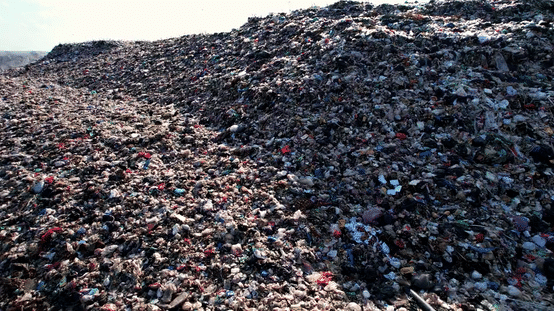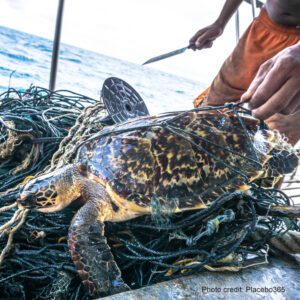
Mar 03, 2022 Plastic Pollution – Challenge for Life Below Water and Life on Land

Endangered Hawksbill Sea Turtle caught in a discarded net
The Challenge
The plastics revolution launched in the 1950s has led to the cumulative production of 8,300 million tonnes (MT) of plastic products and vast quantities of plastic pollution (6,300 MT). According to a Pew Trust report (pg. 25), around 59% of the plastic waste generated in 2016 is “managed” (that is recycled, incinerated, or placed in reasonably well-managed landfills)[1]. The remaining plastic waste can be observed scattered across the globe. Some plastic (an estimated 3-5% annually) leaks into the world’s oceans, where it has become ubiquitous and is now a global environmental focal point. Plastic waste penetrates every marine habitat and is widely consumed by marine animals. Marine mammal and turtle entanglement in plastic debris, mainly discarded or lost fishing gear, has produced iconic images of the dangers of plastic pollution. Meanwhile, the effect of plastic waste on human health is still being debated, but it is clear that humans are consuming microplastics via seafood. Even more worrying, forecasts indicate that new plastic production (and the resulting waste) will double by 2040 if no action is taken.
United Nations Environment Programme (UNEP) Actions
However, the global plastic crisis has now led to the United Nations Environment Programme (UNEP) taking steps to address the challenge of plastic pollution. The second gathering of the Fifth Session of the UNEP’s United Nations Environment Assembly (UNEA-5), held in Nairobi, Kenya, from February 28 to March 2, included a major initiative on plastics and global sustainability. UNEP and UNEA-5 are now emphasizing the importance of Nature, placing it at the core of UNEA’s social, economic, and environmentally sustainable development goals (SDGs). For example, the vital role of Nature is emphasized on the UNEA-5 website as follows.
Full of diversity and complexity, Nature underpins our economies and our societies. Humanity is destroying these life-giving services through over-exploitation, unchecked development and climate change. Collectively we need to protect and restore our natural world.
At UNEA-5, delegates adopted a resolution on plastics titled “End plastic pollution: Towards an internationally legally binding instrument.” The resolution establishes an Intergovernmental Negotiating Committee tasked with drafting a global, legally binding agreement by the end of 2024. The draft should address “the full lifecycle of plastics” and “the design of reusable and recyclable products,” as well as the need for “enhanced international collaboration.” The negotiations and formal approval of the global treaty are optimistically projected to take two years. However, Inger Andersen, Executive Director of UNEP, said this would not pause moving forward. Work will begin immediately on a shift away from single-use plastics and the mobilization of research to encourage the development of a new circular economy for plastics.
How Big is the Plastics Problem?
According to a 2021 US National Academy of Sciences (NAS) report[2], annual plastic production grew from just 2 MT in 1950 to 381 MT in 2015. A more recent OECD publication[3] reported that plastic production in 2019 had increased further to 460 MT and plastic waste to 353 MT. The annual projected growth rate of the plastic output is 4.5% for the period 2021-2030 and 3.5 % for 2031-2050. By 2050, the cumulative numbers for plastic production since 1950 are predicted to reach 34,000 MT, with 26,000 MT of that entering waste streams (see pg. 36 of NAS report). Various recent reports estimate that between 1.7 (OECD) to 11 (Pew) MT of plastic waste enters the world’s oceans each year. While this is a small percentage of total estimated plastic waste, such waste fundamentally alters aquatic ecosystems and has been a major focus for much of the advocacy on plastics.
One takeaway message from the above data recognizes that the reporting and measurement of plastic production and plastic waste streams need to be greatly improved. Another is that ocean plastic pollution, which is damaging the world’s oceans and life below water, is not the only challenge to be addressed. The sheer volume of plastics sitting in managed and mismanaged landfills and littering the terrestrial environment is a continuing challenge for life on land as well.
Suggested Strategies
Development of a Truly Circular Economy for Plastic
The Ellen MacArthur Foundation has emphasized the need for the world to develop a “circular economy” – essentially an economy in which waste and pollution are eliminated, resources are recycled, and economic activity is decoupled from the consumption of finite resources. For plastics, this would require eliminating unnecessary plastic packaging, reducing single-use plastic, and developing 100% reusable, recyclable or compostable plastics.[4]
Better Data
Accurate data and reporting on the extent of plastic production and the plastic waste challenge are currently lacking. Four major reports by the Ellen Macarthur Foundation (2017), the Pew Trusts (2020), the US National Academy of Sciences (2021), and the OECD (2022) all provide estimates of the extent of plastic production and waste generation. However, the estimates differ significantly. Nonetheless, all four reports indicate that global plastic production and consequent waste generation will continue to grow unless measures encourage reduction and recycling. Better reporting will be an essential prerequisite of more effective public policy.
Immediate Engagement
Despite the optimism of obtaining an approved UN Global Treaty within two years, the task is daunting, and the probability of not making that deadline is high. However, all the efforts currently addressing plastic pollution through its lifecycle should continue with every country, corporation, community, and person taking steps to move the ending plastic pollution agenda forward. Governments should use incentives to curb production, discourage use and encourage recycling and responsible disposal. Corporations and businesses should immediately make research and development resources available and a top priority. People can have a tremendous positive impact and should be engaged globally. Objective, credible and accurate information should be available for individuals who seek knowledge to make better individual choices leading to a more sustainable world. This approach to change promotes the idea that small steps taken by many individuals will produce significant global change.
Final Comments
UNEA-5 concluded today (March 2, 2022) but took an important step to develop a treaty addressing plastic waste and pollution. The new treaty will not be limited to just plastic pollution of the oceans but will address the complete lifecycle of plastics from production of resins through consumer products to recycling and waste management. As with energy, the world needs a rapid development of renewable plastics.
————————————–
1 Pew Trusts, 2020. Breaking the Plastic Wave. https://www.pewtrusts.org/-/media/assets/2020/07/breakingtheplasticwave_report.pdf
2 National Academies of Sciences, Engineering, and Medicine 2021. Reckoning with the US Role in Global Ocean Plastic Waste. Washington, DC: The National Academies Press. https://doi.org/10.17226/26132.
3 OECD 2022. Global Plastics Outlook: Economic Drivers, Environmental Impacts and Policy Options. OECD iLibrary. https://doi.org/10.1787/de747aef-en
4 World Economic Forum, Ellen MacArthur Foundation and McKinsey & Company, 2016. The New Plastics Economy — Rethinking the Future of Plastics, (http://www.ellenmacarthurfoundation.org/publications).


